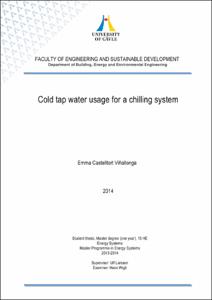Mostra el registre d'ítem simple
Tap water usage for local chilled system
| dc.contributor | Wigö, Hans |
| dc.contributor.author | Castelltort Viñallonga, Emma |
| dc.coverage.spatial | east=17.14127259999998; north=60.6748796; name=Norrtull, Gävle, Suècia |
| dc.date.accessioned | 2015-02-25T16:14:42Z |
| dc.date.available | 2015-02-25T16:14:42Z |
| dc.date.issued | 2013 |
| dc.identifier.uri | http://hdl.handle.net/2099.1/25327 |
| dc.description.abstract | Both the increasing demand for comfort levels and growth in population are facts that assure that the energy demand in buildings will keep growing in the future. HVAC systems are the principal users of this total energy demand, where percentages over 50% have been reached. Air conditioning is essential to maintain the thermal comfort inside the buildings, and for this reason, innovative cooling systems should be analysed in order to reduce and improve energy usage of these systems. The aim of this thesis is to explore the viability and limitations of a new chilling system that uses tap water as a cooling source. The project has been focused on a building owned by an insurance company in Gävle, where a cooling system has been designed to satisfy the cooling need for an extremely hot day in summer. Water is taken from the main pipe and, via a heat exchanger, it absorbs heat from the chilling circuit. The destination of the tap water, once has been used, has been discussed proposing 3 different options: deliver it to the waste, bring it back to the tap water network and reuse it for hot tap water. Later, based on the results, an overview of the system has been done pointing out the weak and strong parts. When implementing this new system it has to be taken into account that cooling capacity is limited and extra requisites and limitations have to be accomplished since drinking water is used. The most energy efficient design is reusing the water for hot tap water use, since less heat will be needed to warm it up. However, if water is wanted to be reused it should not exceed 15! in order to avoid an environment where legionella could grow and become a health human threat. A suitable situation for this system would be for building which needs cooling and has a high hot tap water demand. |
| dc.language.iso | eng |
| dc.publisher | Universitat Politècnica de Catalunya |
| dc.publisher | Högskolan I Gävle |
| dc.rights | Attribution-NonCommercial-NoDerivs 3.0 Spain |
| dc.rights.uri | http://creativecommons.org/licenses/by-nc-nd/3.0/es/ |
| dc.subject | Àrees temàtiques de la UPC::Energies::Termoenergètica::Refrigeració |
| dc.subject.lcsh | Air conditioning -- Equipment and supplies |
| dc.subject.lcsh | Refrigeration and refrigerating machinery |
| dc.subject.lcsh | Feed-water |
| dc.subject.lcsh | Aigua potable |
| dc.title | Tap water usage for local chilled system |
| dc.type | Master thesis (pre-Bologna period) |
| dc.subject.lemac | Aire condicionat -- Aparells i accessoris |
| dc.subject.lemac | Refrigeració i màquines frigorífiques |
| dc.subject.lemac | Aigua d'alimentació |
| dc.subject.lemac | Drinking water |
| dc.rights.access | Open Access |
| dc.audience.educationlevel | Estudis de primer/segon cicle |
| dc.audience.mediator | Escola Tècnica Superior d'Enginyeria Industrial de Barcelona |
| dc.audience.degree | ENGINYERIA INDUSTRIAL (Pla 1994) |
| dc.contributor.covenantee | Högskolan i Gävle |
| dc.description.mobility | Outgoing |


